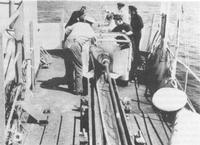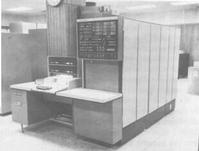


Chapter 8
I Part 1: Communications
i Before the Telegraph
ii Electrical Communication Before Federation
iii Federation to the End of the Second World War
iv Post-war and on to 1975
v 1975 ONWARDS
II Epilogue
III Part 2: Early Australian Computers And Computing
IV Acknowledgements
References
Index
Search
Help
Contact us

Post-war and on to 1975 (continued)
In the process of setting up and clearing of calls, automatic telephone exchanges must necessarily be able to communicate with one another. Basically, the called number must be sent forward to succeeding exchanges while call status information must go to preceding exchanges and, in the case of international communications, signalling needs to be to agreed international standards. The CCITT has recognised a number of signalling systems as suitable for international use and signalling has developed along with communications technology, but by the nineteen sixties it was generally recognised that it was necessary to develop the next generation. No. 6, in international signalling systems. Australia, through both OTC and the APO Research Laboratories, made a substantial contribution to the development of the new system, which was fundamentally different in concept from earlier ones. It uses a separate telephone channel as a signalling link for the transfer of all information and control signals between exchanges, for up to 2048 speech circuits. Thus the speech circuits connecting these exchanges do not possess individual signalling means and all messages carried via the common signalling link must contain identification of the speech circuit to which the message pertains. As a part of the development programme, a field trial exchange with No. 6 signalling capability was supplied by L. M. Ericsson and installed in Sydney, after two engineers from Australia spent fifteen months in Stockholm working with Ericssons on the developments. Simultaneously, the APO Research Laboratories developed their own field trial exchange which also provided valuable early experience of the use of stored program control methods in the Australian network. APO, OTC and their seven international partners used simulated traffic over a fifteen month period to thoroughly test the new signalling system and, in addition, the APO exchange successfully handled a substantial amount of No. 6 signalling link. This work contributed to the successful completion of international trials in 1972 and following this, commercial use of international CCITT No. 6 signalling was inaugurated in July, 1978, with circuits between Australia, the United States and Japan.[40]
As, despite the growth in other services, the International Telegram Service remained a significant segment of communications, there were advantages to be found from automating the service and operating room. Following a feasibility study, a tender schedule was issued seeking a message relay system to provide the following:
- message preparation (entry of messages direct from keyboard into the system) automatic message switching using F31 format
- interworking with and conversion between the national Tress telegram and the international network message formats
- automatic recording and alarm facilities for message numbering (for security)
- electronic storage to provide for the semi-automatic retrieval of past messages
- recording of essential telegram details for customer billing and international accounting
- processing facilities for the production of accounts from the above information

Organisations in Australian Science at Work - Australian Post Office (A.P.O.); CCITT (International Consultative Committee for Telephony and Telegraphy); L. M. Ericsson; Overseas Telecommunications Commission (O.T.C.)
 |
Australian Academy of Technological Sciences and Engineering |  |
© 1988 Print Edition pages 578 - 579, Online Edition 2000
Published by Australian Science and Technology Heritage Centre, using the Web Academic Resource Publisher
http://www.austehc.unimelb.edu.au/tia/560.html